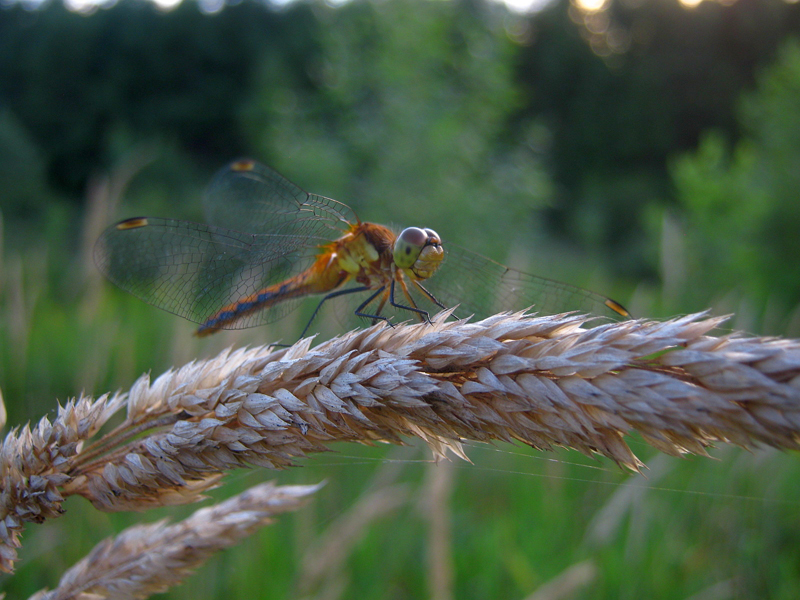Early this summer we were not seeing as many dragonflies as we usually do patrolling the airspace around our yard in the woods. I found this a little disconcerting for two reasons — because we depend on them to clear the air of bloodsucking flying things, and because they’re amazingly graceful. They’re like aerobatic glimpses of another whole world right before your eyes.
Maybe a cold spell or a glut of predators killed more larvae than usual this year down at the brook, which is the nearest water where dragonflies are likely to breed. Or maybe June was too rainy and cloudy, as dragonflies are solar-powered and can’t do much on overcast days. I don’t really know. I missed seeing them.
As July wore on, though, their numbers started to increase, particularly the common whitetails, which are the large dark-colored skimmers that we see most. Petaltails, darners, clubtails and emeralds are some other families of dragonflies, as distinct from damselflies, which are the thin-tailed, streamlined-looking ones. Dragonflies and damselflies make up the order odonata.
Anyway, they mill around the yard like tiny helicopters, snatching flies, gnats, mosquitoes and sometimes even each other directly out of the air with several kinds of lightning quickness. They have a sort of lower lip that shoots out and hauls flies into their toothed maws to be torn apart. Most dragonflies can’t walk, only perch, but they’re among the most nimble fliers in all creation. Their four wings beat independently of each other, not only flapping but twisting like propellers so they can stop, hover, start and make 90-degree corners in any direction with remarkable suddenness.
They can’t hear, either, but truly amazing is their eyesight.
Most of a dragonfly’s head is made up of its eyes, of which there are actually five: three tiny simple eyes on top that probably gauge light intensity, and two large alien-looking bulbs that see almost everything around it except directly behind and directly underneath. A perched dragonfly’s head and eyes will twitch as it watches what’s going on. And what it’s seeing is different in at least four ways from what we see.
First, a dragonfly eye is made up of facets (called ommotidia), which ours aren’t. Each large eye has 10,000 to 30,000 of these hexagonal facets, each of which collects light and creates an image. Those images are compiled in a kind of flicker effect into mosaiclike picture-perceptions.
Second, dragonflies see colors we don’t see. Our eyes detect only a tiny part of all the light there is.
We humans have three color receptor proteins called opsins, which detect red, green and blue wavelengths of light and form those in millions of shades. Dragonflies have four or five opsins that pick up colors beyond blue. Like other insects such as bees, dragonflies can see into the ultraviolet wavelengths of light, where our eyes cannot go.
Third, dragonflies can sort out light angles, which we can’t do. What does this mean? Light waves travel at angles that are vertical, horizontal and otherwise to our eyes. The human eye receives all the angles in roughly the same way, which limits the clarity of our perception to some extent; you notice the limitation in glare. Polarizing sunglasses cut glare to your eyes by filtering out the horizontal rays of light and letting in only the vertical rays. Dragonflies, though, have the ability of polarotaxis, which means their many-faceted eyes sort the angles of light. This apparently helps them judge surfaces and distances, though they can mistake shiny surfaces such as pavement, car roofs or oil slicks for water.
Fourth, dragonflies have a spot on their eyes called a fovea, which is a dense cluster of ommotidia cells that sharpens the images of what they see, especially the blue and ultraviolet colors. Humans, who see very well as creature eyesight goes, also have a fovea, but our eyes are not facet-based, so the fovea’s effect is different for us.
So what do dragonflies see? The flicker effect gives them a keen sense of motion so they can locate and grab flying insects with startling precision. Their polarotaxic ability reveals to them a sky that to us is just a glare, but to them is a bright background that they can navigate by. The colors they see that we don’t are reflecting off flowers, leaves and water; two black-eyed susans that look exactly the same to us have varied color patterns to the dragonfly. Their thousands of facets pick up not just what’s in front of them, but also what’s all around them within a yard or so.
Their little odonate minds are glimpsing moment-by-moment snapshots of a world that we are right in the middle of, but don’t see. So when they were not showing up in the yard this June, I admit I felt a little lost. Was blind, as it were, but now thankfully can see them.
Dana Wilde lives in Troy. His writings on the Maine woods are collected in “The Other End of the Driveway,” available from Booklocker.com and online book sellers. Backyard Naturalist appears the second and fourth Thursdays each month. You can contact him at naturalist@dwildepress.net.
Send questions/comments to the editors.




Comments are no longer available on this story